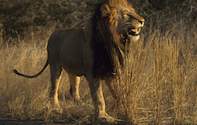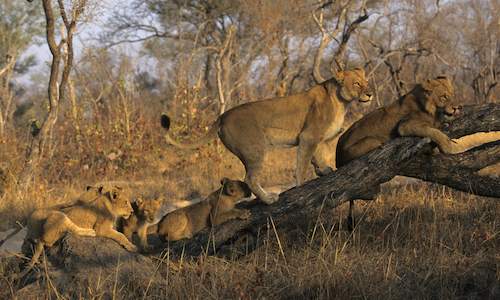
A focus has recently been placed on updating the lion inventory in Africa. In 2012, Tanzania was still listed at the country with the largest number of lions in Africa. In a region of 138,035km², the Selous lion area had a recorded amount of 7,644 lions in 2012. In more recent years, however, the lion inventory in this area has not been properly surveyed.
Previously, individual accounts were made for each lion spotted in the Matambwe area in Tanzania during the dry seasons of 2006 to 2009. An individual photographic identification card was made for each lion that was spotted, and where a pride was spotted, a GPS location was recorded. Two adult females were fitted with radio collars so that their movements within and outside the area could be monitored.One of the best estimates of Africa's lion population in protected areas comes from a paper published in 2004 by Sarel van der Merwe, chairman of the African Lion Working Group, and Hans Bauer from Leiden University in the Netherlands.
Together they surveyed 100 protected areas in Africa by sending questionnaires to researchers, wildlife departments and conservationists across the continent. From this, they derived an estimate of lion numbers as at 2001/2. The picture that emerged from their "Inventory of free-ranging lions Panthera leo in Africa" showed huge variation in lion numbers across the continent.
To lion researchers, Africa is divided into four regions - west, central, east and southern. The eastern and southern populations of lions appear to be doing well, but in west and central Africa the lion populations are small and fragmented.The researchers assessed lion numbers in east Africa at about 11,000 animals, with the continent's largest lion populations being in the Serengeti and Selous ecosystems in Tanzania. Southern Africa's approximately 10,000 lions are mostly in Botswana and South Africa, with about 2,200 of those lions estimated to be in the Kruger National Park.
In eastern and southern Africa there are also thought to be a number of lions still roaming freely outside of the protected areas, but the number of these lions was not expected to improve the precision of the estimate.
The situation in west and central Africa is in strong contrast - here lions have virtually disappeared from non-protected areas, and lion numbers are thought to be declining within protected areas. These lion populations are also genetically isolated from the rest of Africa's lions.The whole region is thought to contain only 1,800 lions. Van der Merwe and Bauer are teamed up once again to look at lion numbers in Africa. Using the previous inventory, they have created a database for the African Lion Working Group, and are planning to carry out annual surveys to refine their records.
Van der Merwe says, "The updating will, no doubt, concentrate on those areas where we are not satisfied with current data, or where no data exist, but new potential respondents have moved in. We will, as in the past, contact respondents per email or hard copy of the questionnaire".
He mentioned Angola and Zambia as being two countries where they are not satisfied with the quality of existing data but that new information may be obtained in the upcoming survey. This new survey will feed into an African Lion Conservation Action Plan, which is currently being drawn up as a result of two lion workshops.
The first workshop took place in Cameroon in 2005, and discussed lions in west and central Africa. The second workshop took place in January this year in Johannesburg, and discussed eastern and southern Africa's lion populations. The action plan will identify areas of high priority for lion conservation. The two workshops identified the main threats to lion populations as loss of suitable habitat, a reduction in the lion's wild prey base and human-lion conflicts.
References
Academia.eduhttps://www.academia.edu/4072491/Methods_for_lion_monitoring_a_comparison_from_the_Selous_Game_Reserve_Tanzania
Lion Alert
https://www.lionalert.org/alert/lions_in/Tanzania
By Melissa Wray
In Africa

 It is estimated that there are currently 1,600 lions in the Kruger National Park, give or take 225 animals, and they are nearly all in tipto...
It is estimated that there are currently 1,600 lions in the Kruger National Park, give or take 225 animals, and they are nearly all in tipto...